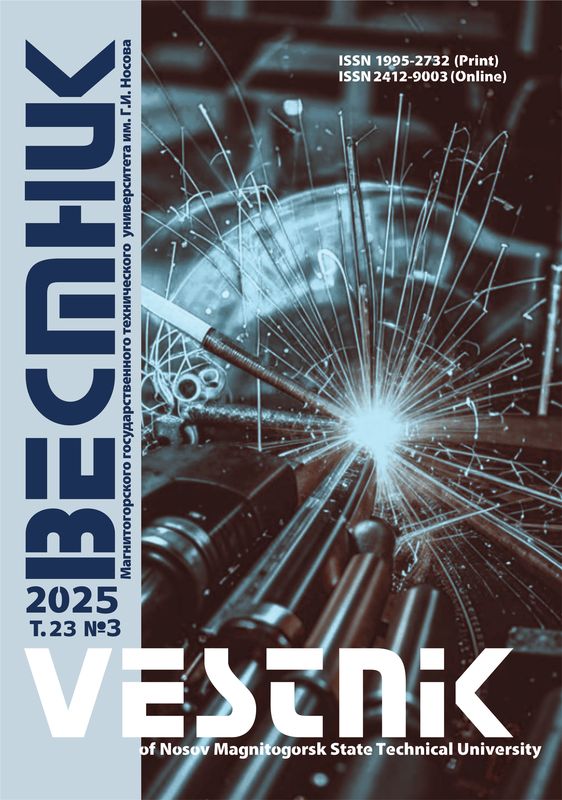DOI: 10.18503/1995-2732-2021-19-4-64-70
Abstract
This paper describes a set of studies carried out on steel grade 08G2S produced by 3D printing by electric arc surfacing at various values of heat input Q. The authors performed a microstructure analysis and low-temperature impact bending tests of the steel grade under study after different deposition schedules. It was found that there was a monotonic increase in the average grain size of the steel with an increase in heat input Q of the 3D printing process. The study shows that the 3D printing mode with heat input Q of 425 J/mm can be selected as optimal from the point of view of producing a homogeneous fine-grained microstructure of steel grade 08G2S, providing high cold resistance. According to the results of low-temperature impact bending tests of steel grade 08G2S, there was an increase in a brittle component in the fracture and a monotonic decrease in impact toughness with decreasing temperature. Ductile-brittle transition temperature t50 for steel grade 08G2S was -40°С. The authors also found a relationship between impact strength of the material under study and the average grain size in a wide range of low temperatures. The digital processing of microstructure images carried out in the course of the study using software developed in the MATLAB environment showed that fractal dimension D of the microstructure image of steel grade 08G2S had a linear relationship with average grain size d and can be used as a quantitative indicator for a quick assessment of cold resistance. From the practical side, the dependences found as a result of the research can be used to predict impact strength and an average grain size of low-carbon manganese steels depending on 3D printing modes.
Keywords
3D printing, steel grade 08G2S, structure, impact strength, cold resistance, fractal dimension.
For citation
Kabaldin Yu.G., Anosov M.S., Ryabov D.A., Kolchin P.V., Shatagin D.A., Kiselev A.V. Study on the Influence of 3D Printing Modes on the Structure and Cold Resistance of Steel Grade 08G2S. Vestnik Magnitogorskogo Gosudarstvennogo Tekhnicheskogo Universiteta im. G.I. Nosova [Vestnik of Nosov Magnitogorsk State Technical University]. 2021, vol. 19, no. 4, pp. 64–70. https://doi.org/10.18503/1995-2732-2021-19-4-64-70
1. Elistratova A.A., Korshakevich I.S. 3D printing technologies: advantages and disadvantages. Aktualnye problemy aviatsii i kosmonavtiki [Current problems of aviation and cosmonautics], 2015, vol. 1, pp. 557–559. (In Russ.)
2. Comparison and analysis of different 3D printing techniques. International Journal of Latest Trends in Engineering and Technology. 2017, vol. (8), issue (4–1), pp. 264–272. DOI:10.21172/1.841.44
3. Tong L., Niu L., Jing S., Ai L., Zhao X. Low temperature impact toughness of high strength structural steel. Thin-Walled Structures. 2018, issue 132, pp. 410–420. DOI: 10.1016/j.tws.2018.09.009
4. Khlybov A.A. et al. The effect of low temperatures on the operability of products 20GL steel. 2020 J. Phys.: Conf. Ser. 1431 012063. DOI:10.1088/1742-6596/1431/1/012063
5. Shakhov V.N., Bogdanov V.V. Evaluation of grain points by a fractal analysis method. Aktualnye problemy aviatsii i kosmonavtiki [Current problems of aviation and cosmonautics], 2014, no. 10. Available at: https://cyberleninka.ru/article/n/otsenka-balla-zerna-metodom-fraktalnogo-analiza (Accessed on July 27, 2021).
6. Malykh M.V., Sobko S.A., Titova O.V. Application of a fractal analysis to determine the grain size of deformed materials. Available at: https://www.sphti.ru/wp-content/ uploads (Accessed on July 27, 2021).
7. Kabaldin Yu.G., Shatagin D.A., Anosov M.S., Kolchin P.V., Kiselev A.V. Diagnostics of 3D printing on a CNC machine by machine learning. Russian Engineering Research, 2021, vol. 41, no. 4, pp. 320–324.
8. Khlybov A.A., Kabaldin Yu.G., Anosov M.S., Ryabov D.A. , Sentyureva V.I. Problems of ensuring a safe operation of freight car bogies at negative temperatures. Vestnik IzhGTU imeni M.T. Kalashnikova [Bulletin of Kalashnikov ISTU], 2019, vol. 22, no. 4, pp. 18–26. DOI: 10.22213 / 2413-1172-2019-4-18-26
9. Kabaldin Yu.G., Anosov M.S., Shatagin D.A. Evaluation of the mechanism of the destruction of metals based on approaches of artificial intelligence and fractal analysis. IOP Conf. Series: Materials Science and Engineering 709 (2020) 033076 IOP Publishing. doi:10.1088/1757-899X/709/3/033076
10. Poletaev Yu.V., Poletaev V.Yu. Single-pass electric arc welding under a thin layer of slag of thick-sheet structures of 09G2S steel. Vestnik Donskogo gosudarstvennogo tekhnicheskogo univetsiteta [Bulletin of Don State Technical University], 2018, vol. 18, no. 1, pp. 50−58. (In Russ.)
11. Uzlov I.G., Babchenko A.I. , Dementyeva Zh.A., Kononenko A.A., Safronov A.L. Influence of microstructure parameters of wheel steel on its ductility properties. Fundamentalnye i prikladnye problemy chernoy metallurgii: sb. nauch. tr. [Fundamental and applied problems of ferrous metallurgy: Collection of research papers]. Dnipropetrovsk: IFM NAS of Ukraine, 2007, no. 14, pp. 202–210. (In Russ.)
12. Toporov G.V., Smokotin G.Ya. Influence of a grain size on impact-fatigue resistance of steel 45. Izvestiya Tomskogo politekhnicheskogo instituta [Bulletin of Tomsk Polytechnic Institute], 1958, vol. 106: Drilling machines, pp. 153–164. (In Russ.)












